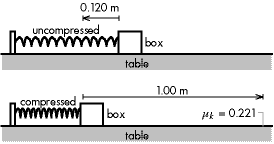Cuesta College, San Luis Obispo, CA
Physics 8A learning goal Q7.4
[3.0 points.] Consider a 0.600 kg box that is held against a horizontal spring of negligible mass, compressing the spring a distance of 0.120 m. When released, the box moves along a horizontal table for 1.00 m before coming to a rest. (This 1.00 m distance includes the distance covered by the box while the spring was still pushing it.) The coefficient of kinetic friction between the box and table is 0.221. Neglect air resistance.

Which one of the following choices best corresponds to the spring constant of the spring?
(A) 180 N/m.
(B) 408 N/m.
(C) 817 N/m.
(D) 3.70E+03 N/m.
(Cf. Young and Freeman, University Physics, 11/e, Problem 7.43.)
Correct answer: (A)
The decrease in spring potential energy of the unknown mass box is equal to the (non-conservative) work done by friction. Where d = +0.120 m, and x_f = 0 then:
k = (2*(µ_k)*m*g*d)/(x_i^2) = 180 N/m.
Somehow equating the decrease in spring potential energy to an increase in gravitational potential energy (?) results in the incorrect response (C):
k = 2*m*g*d/(x^2),
with another incorrect response (B) being similar, but without the factor of 2.
Student responses:
(A) : 10 students
(B) : 12 students
(C) : 8 students
(D) : 1 student
No comments:
Post a Comment